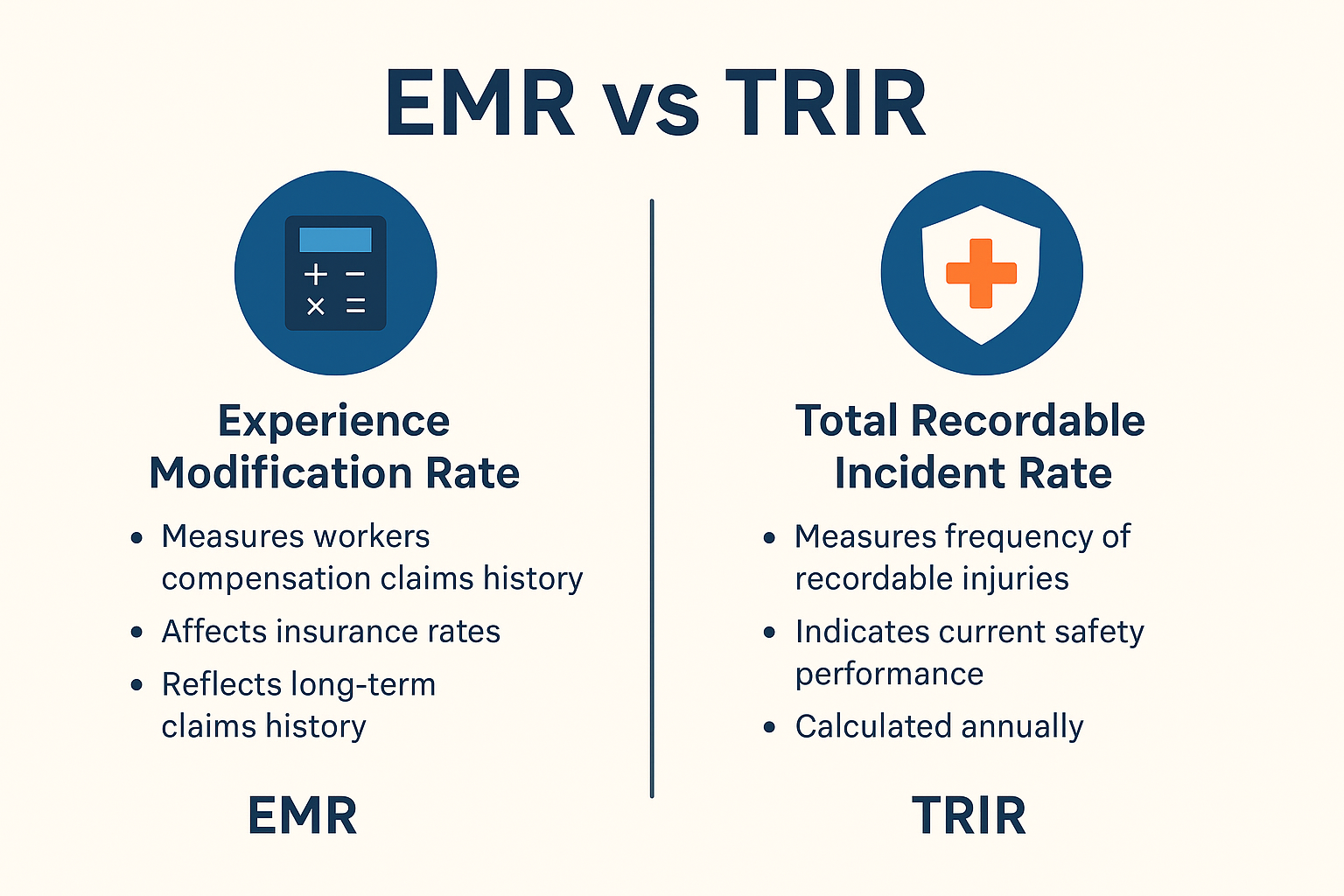If you’re responsible for health and safety on the job site, especially in high-risk fields like construction or manufacturing, you’ve probably heard of EMR and TRIR.
The Experience Modification Rate (EMR) and the Total Recordable Incident Rate (TRIR) are both used to evaluate a company’s safety performance. They reflect how well you protect your workers, handle risks, and comply with occupational safety standards.
However, while these metrics may sound similar, they serve very different purposes. Understanding the difference between EMR vs TRIR can help you build a safer workplace, lower insurance costs, and stay competitive when bidding for projects.
Let’s take a closer look at how these two safety metrics work and why both matter.
What Is EMR?
EMR, or Experience Modification Rate, is a key safety metric used by insurance companies to calculate your workers’ compensation insurance premiums. It compares your company’s past workers’ compensation claims against those of similar companies in your industry.
A baseline EMR is 1.0. If your company has fewer severe incidents than average, your EMR drops below 1.0, earning you lower insurance premiums. But if your claims history shows more severe incidents, your EMR will rise, signaling higher risk and increasing your costs.
This makes EMR both a lagging indicator of past incidents and a financial signal of your company’s overall safety performance. Regulatory bodies, clients, and project managers often check EMR scores before awarding contracts, especially in the construction industry.
How EMR Is Calculated
Insurers determine your EMR by comparing:
- Actual losses (based on past workers’ compensation claims)
- Expected losses (based on industry data and company size)
The result reflects your safety record, and it remains one of the most impactful metrics for competitive advantage, especially in high-risk fields.
Why It Matters
EMR directly affects your bottom line. A higher EMR leads to increased workers’ comp insurance premiums, while a lower EMR can mean significant cost savings.
It also plays a role in how your company is perceived. Clients, general contractors, and regulatory agencies often use EMR as a benchmark for safety.
A strong EMR shows you’re managing risks well, which can improve your chances of winning contracts, especially in industries where safety is critical.
What Is TRIR?
TRIR, or Total Recordable Incident Rate, is a safety metric used to measure the number of Occupational Safety and Health Administration (OSHA) recordable incidents that occur at a company per 100 full-time employees over the course of a year.
TRIR focuses on the frequency of workplace incidents like injuries, illnesses, or medical treatments that meet OSHA’s recordability criteria. This includes incidents requiring more than first aid, lost or modified workdays, or a job transfer.
The TRIR Formula
To calculate TRIR:
- TRIR = (Number of Recordable Incidents × 200,000) ÷ Total Number of Hours Worked
The 200,000 figure represents the number of hours 100 employees would work in a year, based on a standard 40-hour work week.
Why It Matters
TRIR is a lagging indicator of workplace safety, offering insight into how frequently safety incidents are occurring.
A high TRIR may trigger OSHA inspections, signal poor safety practices, or affect your reputation with regulatory bodies and clients.
A low TRIR, on the other hand, communicates a strong safety culture and regulatory compliance, and positions your business more favorably in competitive bids.
EMR vs TRIR: Key Differences
While both EMR and TRIR reflect a company’s safety performance, they serve distinct purposes and are calculated in very different ways.
Here’s how they differ:
What They Measure
EMR evaluates a company’s workers’ compensation claims history and compares it to the industry average. It reflects the cost and frequency of past incidents, which can directly impact insurance premiums.
TRIR, for its part, focuses on the number of OSHA recordable incidents, providing a frequency-based view of a company’s work-related injuries, illnesses, and recordable events.
How They’re Used
EMR is primarily used by insurance providers and clients to assess risk. A higher EMR means more claims than expected, leading to higher workers’ compensation insurance premiums.
TRIR is used by regulatory bodies (like OSHA) and safety professionals to track incident trends, set benchmarks, and monitor future performance.
Calculation and Data Sources
EMR is calculated using data from past cost of claims over a 3-year period, adjusted by the National Council on Compensation Insurance (NCCI) or a state rating bureau.
TRIR is calculated using the TRIR formula based on hours worked and recordable incidents reported per OSHA guidelines.
Strategic Implications
A low EMR can offer a competitive advantage in bidding for contracts, especially in the construction industry.
A low TRIR indicates good safety practices, reduces the risk of OSHA citations, and signals strong regulatory compliance.
TRIR and EMR: Common Misconceptions
It’s easy to confuse TRIR and EMR; after all, both are safety metrics used to assess workplace incidents. But they’re not interchangeable.
Here are some common misconceptions about the two:
Misconception 1: High TRIR Automatically Means Higher Insurance Rates
A high TRIR doesn’t always lead to increased insurance premiums. Your modification rate depends more on the severity of injuries and the cost of claims, not just the number of incidents.
A company might have an average TRIR but a high EMR due to long recoveries or costly medical treatments.
Misconception 2: All Injuries Count Toward TRIR
Only incidents requiring medical attention beyond first aid are considered recordable injuries under OSHA rules.
Misclassifying minor incidents can distort your TRIR calculation and lead to unnecessary concern about your company’s safety performance.
Which Metric Should You Prioritize: EMR or TRIR?
Understanding EMR vs TRIR isn’t just a matter of terminology. It’s about aligning your safety metrics with what matters most to your organization, whether that’s financial outcomes, regulatory compliance, or operational safety performance.
Focus on EMR for Financial Impact and Insurance Costs
EMR is a reflection of your company’s workers’ compensation claims history compared to similar companies in your industry. And it directly influences your workers’ compensation insurance premiums.
It’s also often used as a benchmark for past performance and expected losses in the bidding process, especially in the construction industry.
If your goal is to reduce long-term insurance costs, win competitive contracts, or improve your standing with clients, EMR is the key metric to monitor.
Prioritize TRIR for Operational Safety and Compliance
TRIR, on the other hand, is a real-time snapshot of your occupational safety performance. And it is especially valuable for regulatory compliance, internal reporting, and triggering safety reviews.
If you want to make sure you adhere to operational safety and compliance regulations, TRIR must be paramount in your safety monitoring.
How EMR and TRIR Work Together to Improve Safety and Operational Oversight
EMR and TRIR work best when used together, offering a clearer picture of both real-time risks and long-term trends.
TRIR Tracks Present-Day Safety Performance
Because TRIR responds quickly to changes in your operations, it’s a valuable leading indicator of current safety performance.
Tracking TRIR helps you identify potential hazards, implement corrective actions, and gauge how well your safety program is working right now.
EMR Measures the Long-Term Financial Impact
EMR is a lagging indicator that compares your company’s workers’ compensation claims to the industry average, as tracked by the National Council on Compensation Insurance. It reflects the direct impact of serious injuries, lost workday cases, and past incidents on your insurance rates.
A high EMR signals poor historical performance, while a low one gives you a financial advantage. Since EMR affects how much you pay for coverage, it’s a critical benchmark for how your company operates over time.
Combined, They Strengthen Your Safety Strategy
Monitoring both TRIR and EMR supports better decision-making. You get immediate insights through TRIR and long-term cost analysis through EMR, two sides of the same safety coin.
Together, they help your team:
- Compare progress against the industry average TRIR
- Uncover recordable incidents before they lead to deaths (total number) or litigation
- Show leadership you’re meeting OSHA and health administration expectations
- Make data-driven improvements that support employee well-being
With regular monitoring and actionable responses, you can move from reactive compliance to proactive risk management.
Take Control of EMR and TRIR with EHS Momentum
Tracking TRIR and improving your EMR requires more than spreadsheets. It takes a strategic system that combines data, oversight, and action.
EHS Momentum delivers exactly that, through MyMomentum.
MyMomentum: Turn Metrics Into Measurable Action
MyMomentum, our digital safety management platform, offers powerful tools to track recordable injuries, identify potential hazards, and monitor your TRIR with precision.
It helps you keep a pulse on work-related injuries, manage record-keeping, and reduce serious injuries through built-in workflows and real-time monitoring.
With support for labor statistics, incident tracking, and leading indicators, MyMomentum makes it easier to meet your compliance goals and lower your modification rate over time.
Book a demo today to see how MyMomentum can help you build a safer, more cost-effective operation.
FAQs About EMR vs. TRIR
What is EMR and TRIR?
EMR is a financial measure based on your company’s past workers’ compensation claims. TRIR measures the frequency of OSHA-recordable incidents like medical treatment or lost workdays within a year.
Both reflect aspects of your safety performance, but from different angles.
Is EMR a leading indicator?
No. EMR is a lagging indicator. It reflects past incidents, serious injuries, and the modification rate applied to your insurance rates based on historical claims, not current conditions.
What is the OSHA EMR rating?
The OSHA EMR rating refers to your company’s experience modification rate, typically calculated by the National Council on Compensation Insurance.
A score of 1.0 is considered average, with lower scores preferred for contracts in the construction industry and beyond.
What does EMR stand for in safety?
In safety, EMR stands for Experience Modification Rate. It shows how your company’s recorded injuries and compensation costs compare to others in your industry.
It can influence your insurance premiums, contract eligibility, and overall safety reputation.







